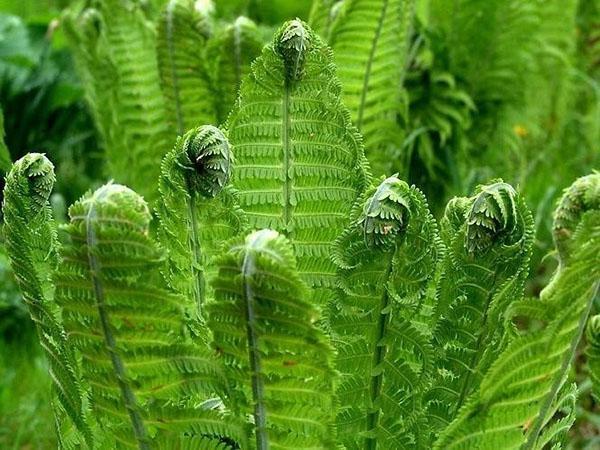The ostrich fern is intended for shaded areas
 Wastelands are always formed under the crowns of large trees in the garden, which you so want to fill with something. It is for these purposes that the ostrich fern is planted. With sufficient watering and excellent shade, its branches grow up to 1.5 meters. The curved edges of the corrugated leaves add to the beauty of the spectacle. A light breeze and feathers seem to come to life.
Wastelands are always formed under the crowns of large trees in the garden, which you so want to fill with something. It is for these purposes that the ostrich fern is planted. With sufficient watering and excellent shade, its branches grow up to 1.5 meters. The curved edges of the corrugated leaves add to the beauty of the spectacle. A light breeze and feathers seem to come to life.
You can buy seedlings either on the market or dug up directly in the forest. However, in central Russia, as well as in Ukraine, only kochedyzhniks grow well.
The ostrich fern creates exquisite decor
This culture has never had problems with reproduction, since the rhizomes grow with lightning speed. They sprout out processes that cling to new areas with their tentacles. You can stop its movement in the garden by planting a plant in a confined space, for example flower bed with borders. By planting just one root, after a while the gardener in the front garden will have a whole family.
The root system cannot harm other "neighbors" in any way, because it is located at a scanty depth. Therefore, by placing ostrich fern bushes between low-growing thujas, the florist will create the effect of a forest on his site. In such thickets, a humid microclimate is formed. At the same time, the openwork shadow originally falls on the desert land.
Planting recommendations
Drafts are an important point when choosing a place. The culture is very difficult to tolerate windy areas. The air currents swing the fronds so hard that they break. Also, it is not recommended to plant wilted rosettes of herbaceous shrubs. This happens when, upon purchase, it is cut off from the main rhizome. And even if the bush is watered abundantly, there is no chance that it will take root. Therefore, after planting, all branches should be cut off, leaving 10 cm rods. Next year they will produce beautiful fronds. Moreover, the ostrich fern loves:
- Bad soil. To do this, pour his native soil into the hole - forest and with foliage.
- Drainage. A loose structure is obtained by combining broken residues of building materials and clay. All this maintains the moisture balance that the plant desperately needs.
- Neighborhood with an apple tree. The foliage of these trees provides it with a natural habitat. When the fallen leaves are overheated, the roots are nourished with useful components.
- Watering and shade. During dry seasons, some gardeners install automatic irrigation systems.
So, now the main thing is not to interfere with the fern growth. Therefore, you need to immediately bury breeding limiters in the ground: pieces of slate or metal. Then the exquisite bushes will not turn from a decorative exhibit into an ordinary weed.